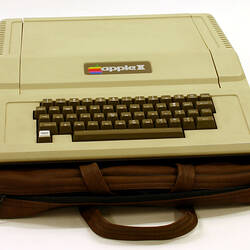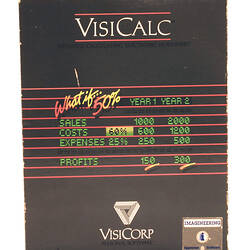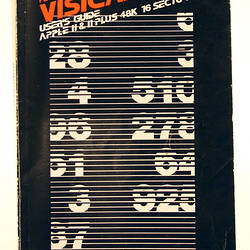In May 1979, the donors acquired this Apple II computer for their Melbourne-based architectural practice. They used the computer intensively for eight years with a wide variety of professional and commercial applications. They experienced the period when personal computers began to be widely available and a useful commodity.
They experimented with what a computer could do at a time when there was a complete lack of commercially useful software available - before the emergence of boxed software for almost any sort of personal computer.
The Apple II initially arrived with a cassette tape data drive (which was used to load pre-recorded programs, which were largely demonstrations, and simple utilities and games) as the Apple Disk II 5 1/4" floppy disk drives weren't yet being shipped. The donors purchased an Australian-made PAL television interface card from Electronic Concepts, the local Apple distributors in Sydney, so that they could use a small HMV Nipper colour TV set as the computer's monitor. The donors had a dot-matrix impact printer as a workhorse and an IBM Selectric 'golf-ball' typewriter for finished presentation documents. Both were very loud, and the whole printing operation was relegated to a separate room.
Before too long, VisiCalc appeared and the spreadsheet came to underpin all of the practice's professional data analysis, numerical modelling, bookkeeping and financial analysis until it and two companion Apple II computers were superseded by a small network of Apple Macintosh computers in 1986-7.
After VisiCalc (which is the direct forerunner of Excel), wordprocessing applications, 2D and 3D graphics modelling systems, Computer-Aided Drafting (CAD) and database applications all became available - in approximately that order over the next five years. 'Robocom' software from the UK was in use well before Autocad was heard of. The Apple II system was soon indispensable, and used by a number of professional and support staff, for up to 12 or more hours per day.
The donors recalled that at all stages, their use of the Apple II was at the leading edge of the application of computers in architectural practice. One of the partners conducted numerous professional development seminars around Australia for other practising architects and undergraduate professional practice units in local universities and colleges, based on the ground breaking use of the Apple II in architectural and planning practice.
The donors found that since the Apple II arrived, computers haven't been out of their daily lives, whether at work, university or for leisure.
More Information
-
Keywords
-
Authors
-
Contributors
-
Article types



